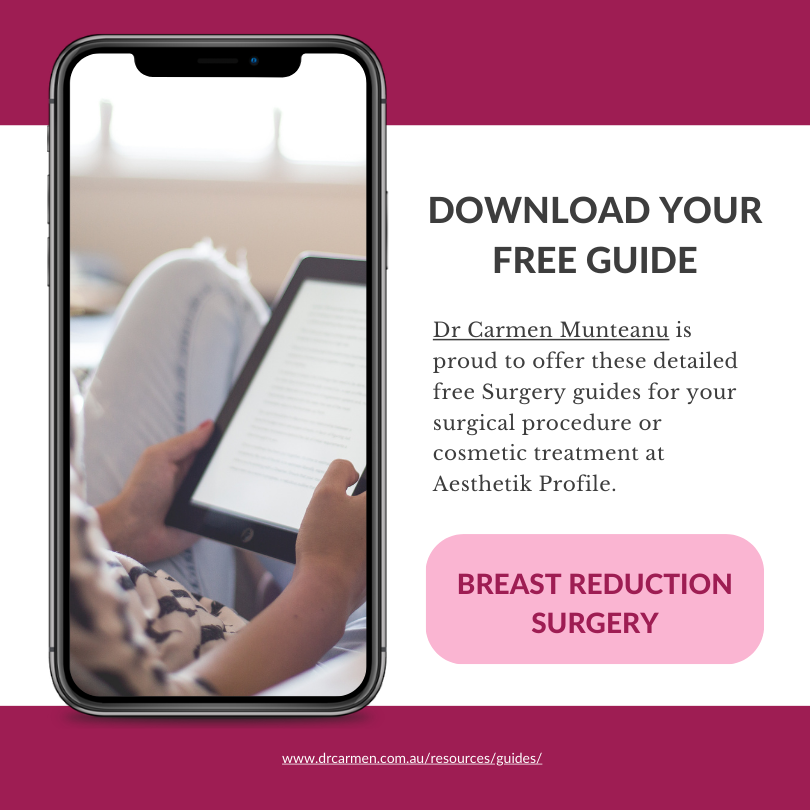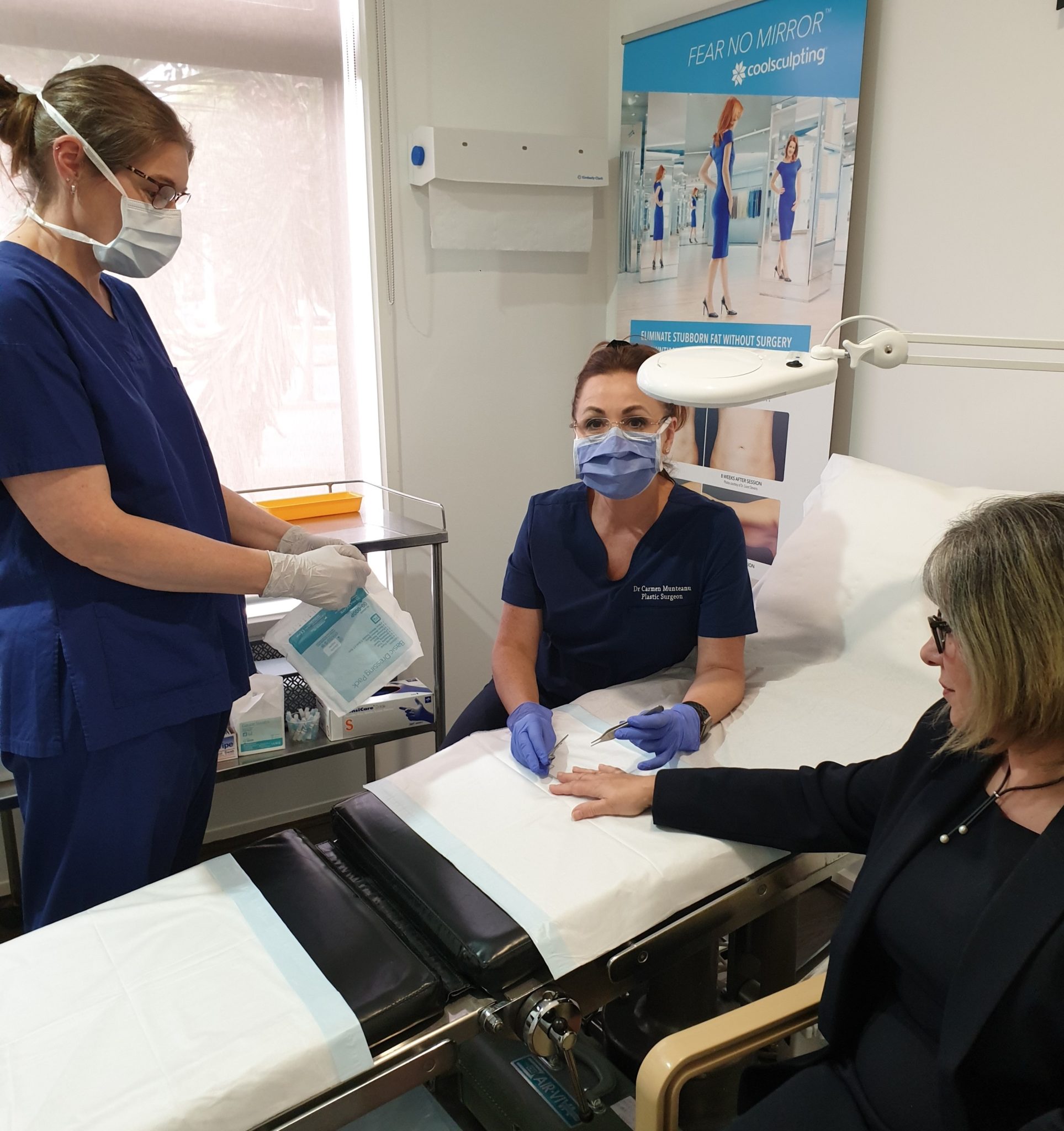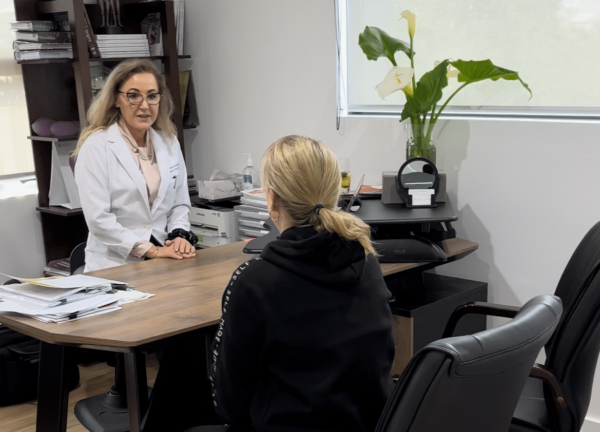Why It Is Important to Use Compression Garments for Breasts after Surgery
Compression garments after breast reduction surgery are specially designed to provide support, enhance circulation, reduce swelling, and aid in the healing process, particularly post-operative recovery. These functional pieces of clothing, often recommended by plastic surgeons, come in various types, including surgical bras, sports bras, and vests, each with specific purposes and benefits.
The importance of these garments cannot be understated. For women who have undergone surgery, a breast augmentation, reduction, lift, or reconstruction, these compression garments play a pivotal role in shaping the recovery journey. They help manage post-operative swelling, reduce the risk of complications, and facilitate the healing process by providing consistent pressure and support to the surgical site.
Melbourne Specialist Plastic Surgeon Dr Carmen Munteanu places great emphasis on the complete patient journey, including the recovery period.
Take our Plastic Surgery Quiz to find out if you’d be a good candidate and if you are ready for cosmetic surgery.
What Are Compression Garments For Breasts?
Compression garments for breasts are specially designed pieces of clothing that provide support and pressure to the breast area. Their main functions include enhancing blood circulation, reducing swelling, and aiding in the healing process, especially after surgical procedures.
Types of Compression Garments:
There are several types of compression garments for breasts, each serving specific needs and purposes:
- Surgical Bras: These are generally prescribed after surgical procedures such as breast augmentation, reduction, lift, or reconstruction. They provide support, minimise movement, and help in managing post-operative swelling and discomfort
- Sports Bras: Designed for physical activities, these provide support, minimise bounce, and help to prevent discomfort or pain during exercise. They often feature moisture-wicking materials for added comfort during intense activities
- Compression Vests or Binders: Often they are used post-surgery or for those requiring extra support, these garments provide uniform compression and stability across the entire upper body, including the breasts
How Do Compression Garments Work?
The most important things related to the compression garments for breasts are their design and material. They exert a controlled amount of pressure on the breast tissue, enhancing blood flow to the area. This increased circulation helps reduce swelling and inflammation, accelerates the healing process, and helps flush out toxins from the body. Furthermore, by providing adequate support and limiting excessive movement, these garments help prevent strain and potential tissue damage.
When Are Compression Garments Required?
Compression garments for breasts come into play in a variety of scenarios:
- Post-Operative Care: They are most commonly used after breast-related surgeries to facilitate recovery, manage swelling and discomfort, and reduce the risk of complications
- Sports Activities: During physical exercises, they provide essential support to prevent discomfort and potential damage caused by excessive breast movement
- Specific Health Conditions: In some cases, such as lymphedema or back pain due to large breasts, healthcare professionals may recommend wearing these garments for relief and support
The Evolution of Compression Garments for Breasts
The roots of compression garments can be traced back to ancient times when bandages were used to bind and support various body parts. However, the specific application for breasts didn’t evolve until much later. The precursor to modern compression garments, the bra, has undergone significant transformations since its invention in the late 19th century, from uncomfortable corsets to more practical and comfortable designs.
In the early and mid-20th century, medical compression garments started making their mark. These garments were primarily designed for post-surgical patients to reduce swelling and promote healing. However, they lacked comfort and were far from aesthetically pleasing.
With the fitness boom of the 1970s and 1980s, sports bras were introduced to provide support during high-intensity activities, marking a significant milestone in the evolution of compression garments for breasts.
Modern Innovations
Fast forward to today, and we see a world of difference in the design, functionality, and materials used in compression garments for breasts. Modern innovations have improved their efficiency, comfort, and appeal significantly:
- Material Technology: The use of fabrics like spandex and advanced microfibers has made compression garments more breathable, comfortable, and effective. These fabrics allow for controlled compression, moisture-wicking, and long-lasting durability
- Smart Compression: Cutting-edge technology has enabled the creation of garments that adapt their compression levels based on the wearer’s movement, providing optimal support whenever necessary
- Personalised Fit: Today’s compression garments are designed to accommodate all shapes and sizes. Innovations such as adjustable straps, closures, and multiple cup sizes have made it possible for each woman to find a garment that fits her perfectly
- Aesthetic Appeal: Today’s compression garments are not only functional but also aesthetically pleasing. They come in a variety of styles, colours, and patterns, making them a fashionable addition to any wardrobe
Things to Consider Before Buying Compression Garments after Breast Reduction
Choosing the Right Fit and Material
Choosing the right fit and material is crucial when purchasing compression garments for breasts. The right fit ensures optimal support and comfort, while the material affects breathability and durability. Here are some tips:
- Size: A garment that is too tight can restrict blood flow and cause discomfort, while one that’s too loose may not provide the necessary support. Use sizing guides provided by manufacturers, and don’t hesitate to try on different sizes to find the perfect fit
- Style: The style should align with your purpose of use. Surgical bras are designed for post-operative care, sports bras for physical activities, and compression vests and binders for more comprehensive upper body support
- Material: Look for breathable, stretchable, and durable materials. Moisture-wicking fabrics are ideal for sports activities, while softer, seamless materials are better for post-operative care
Price vs. Quality
While it’s essential to consider the cost, you should not compromise on the quality of the garment. High-quality compression garments might come with a higher price tag, but their durability, comfort, and functionality justify the cost. Look for products that provide value for money rather than simply going for the cheapest option.
Remember, buying a compression garment for breasts is an investment in your health and well-being. So, take the time to make an informed decision that ensures comfort, meets your specific needs, and ultimately supports your journey towards better breast health.
Download Dr Carmen’s Guide to Breast Reduction Surgery – Reduction Mammaplasty

Myths and Misconceptions about Compression Garments
As with many health-related products, there are several myths and misconceptions associated with compression garments for breasts. Let’s address some of the most common ones:
Myth: They are only for post-surgery use.
Fact: While it’s true that compression garments are often recommended for post-surgery recovery, their usage extends well beyond this. They are also utilised for sports and physical activities to minimise breast movement and associated discomfort. Moreover, they can provide relief to individuals dealing with certain health conditions like lymphedema or back pain due to larger breasts.
Myth: They can cause harm if worn for long periods.
Fact: Compression garments are designed to exert a specific amount of pressure beneficial for blood circulation and tissue support. However, like any other garment, the key lies in proper fit and usage. A well-fitted garment should not cause harm even if worn for extended periods.
Myth: Compression garments will reduce breast size over time.
Fact: Compression garments do not permanently alter breast size. They provide temporary support and shape, but they do not have a lasting impact on breast tissue.
Myth: All compression garments are uncomfortable.
Fact: While comfort can be subjective and vary among individuals, modern compression garments are designed with user comfort in mind. Innovations in fabric technology and design have led to garments that are breathable, soft, and flexible while still providing the necessary support.
Tips for Wearing Your Compression Garment Comfortably
Wearing a compression garment after breast reduction surgery can initially feel strange or even uncomfortable. However, with a few practical tips, you can ensure a more comfortable experience:
- Correct Fit: It’s critical to choose a compression garment that fits you well. An ill-fitting garment could cause discomfort or even compromise your healing process. Your surgeon can help determine the correct size for you
- Regular Breaks: While it’s crucial to wear your compression garment as much as possible, short breaks (as per your doctor’s instructions) can provide temporary relief from any discomfort or pressure
- Proper Maintenance: Keep your garment clean to prevent skin irritation or infection. Most garments are machine washable, but always follow the manufacturer’s care instructions
Risks Involved in Not Using Compression Garments
Following a breast reduction surgery, the use of compression garments is generally advised by surgeons for a multitude of reasons. Neglecting to use these can potentially increase the risk of complications and hinder the healing process. Here are some of the main risks involved in not using compression garments:
- Increased Swelling: One of the main functions of a compression garment is to help reduce swelling by applying consistent pressure to the surgical area. Without this, patients might experience excessive swelling, which can be uncomfortable and slow down the healing process
- Seroma Formation: A seroma is a pocket of clear bodily fluid that sometimes develops after surgery. Compression garments can help minimise the risk of seroma formation by facilitating fluid drainage and reducing empty spaces where fluid could accumulate
- Haematoma Risk: Haematomas, or blood-filled swelling, is another possible post-surgical complication. Compression helps in minimising the risk by constricting blood vessels and reducing bleeding
- Impaired Skin Retraction: After breast reduction, the skin needs to retract and adapt to the body’s new contours. Compression garments aid this process, ensuring the skin fits correctly to the new breast shape. Without them, skin retraction might be uneven or less than optimal, impacting the aesthetic outcome
- Prolonged Healing Time: Overall, not wearing a compression garment can lead to a lengthier recovery period. The benefits of compression in reducing swelling, promoting skin retraction, and preventing seroma or haematoma all contribute to a smoother, faster healing process
- Discomfort: While compression garments might feel uncomfortable initially, they actually enhance comfort during the recovery period. By reducing swelling and supporting the healing tissues, they can make the post-surgery experience less painful
FAQs about Wearing Compression Garments

Can I remove the compression garment at night?
- The recommendation is to wear your compression garment all the time for the prescribed period. This includes nighttime. The continuous pressure it provides helps to minimise swelling and support the healing tissues. However, your surgeon may suggest specific periods where you can remove it, such as during showering or for brief breaks. Always follow your surgeon’s specific advice on this matter.
Are compression garments painful?
- While compression garments can initially feel tight or uncomfortable, they should not cause pain. The goal is to provide support and pressure, but not to the point of causing distress. If you experience ongoing discomfort or pain, it might be an indication that your garment is not the correct size or that there is another issue needing attention.
Can I wear a regular bra after surgery?
- The timing for when you can transition back to a regular bra post breast reduction surgery will depend on your unique healing process. Generally, your surgeon will advise waiting a few weeks until the majority of swelling has subsided and healing is well underway. It’s important not to rush this process, as wearing a regular bra too soon can apply pressure in areas that are still healing and cause discomfort or issues.
How do I clean my compression garment?
- The majority of compression garments are designed to be machine-washable for easy care. However, it’s important to always follow the specific care instructions provided with your garment. This usually involves washing on a gentle cycle and air-drying, as high temperatures from a dryer can damage the garment’s elasticity and effectiveness.
When can I stop wearing the compression garment?
- The duration for wearing a compression garment varies based on the specific type of surgery, your individual healing process, and your surgeon’s recommendations. It’s commonly advised to wear the garment for several weeks post-surgery, but this can vary. Your surgeon will provide guidance on when you can start phasing out the use of your compression garment. Remember, the goal is to support your healing process.
Further Reading about Breast Surgery with Dr Carmen
- Read Dr Carmen’s Blog about Recovery After Breast Lift Surgery – Tips, Timeline and Healing
- Read Dr Carmen’s Fat Transfer to Breast
- Read Dr Carmen’s Breast Implant Replacement
- Read Dr Carmen’s blog about Best Compression Garments for Plastic Surgery Patients
- Read Dr Carmen’s Blog about How Can I Reduce Swelling and Bruising After Breast Reduction Surgery
- Read Dr Carmen’s Blog about How to Reduce Scars after Breast Reduction
Medical References about Garment Compressions
- Compression Garments for Medical Therapy and Sports – NCBI
- Putting the Squeeze on Compression Garments – NCBI
- Benefits of Compression Therapy – WebMD
- Compression Therapy: Types and Benefits – Cleveland Clinic






